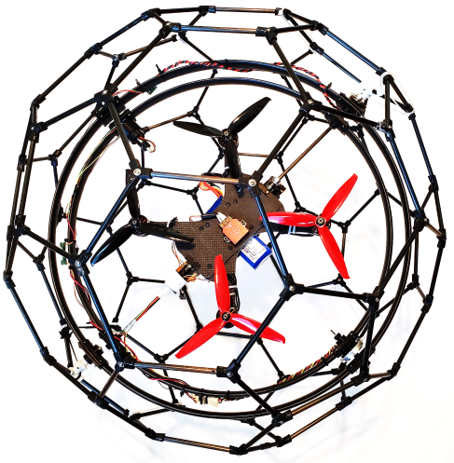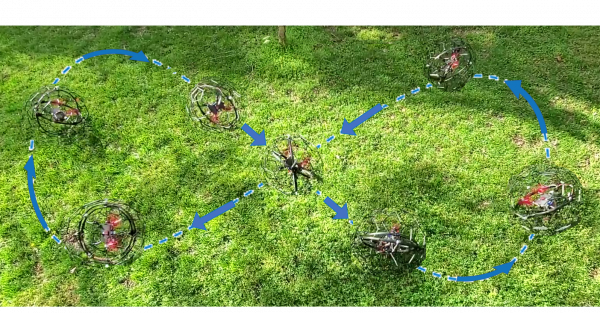Autonomous Exploration Rolling-Flying Vehicles

MAE researchers are developing a new class of autonomous robotic vehicles that combine the mobility of flight with the endurance of rolling locomotion for mapping and exploring subterranean spaces. Led by doctoral students Stefan Atay and Tyler Jenkins and faculty advisors Gregory Buckner and Matthew Bryant, this project aims to address the needs of the US Army Special Operation Command (USASOC) personnel who must operate in uncharted, and potentially hostile, underground environments. The lack of satellite imagery and the inefficacy of GPS and other radio communications technology underground makes these operations exceptionally dangerous for special operations forces; they must execute their operation in a dangerous, underground maze, in the dark, with no map. The team’s research focuses on developing mobile robotic mechanisms that are suited for subterranean operation. These mobile robots must exhibit excellent mobility and maneuverability (traversing any obstacles, navigating narrow passages, etc.) and great endurance, (the ability to operate for extended periods over great distances) in a GPS-denied environment. Typical mobile robotic solutions demonstrate either excellent mobility and maneuverability (e.g. multirotor craft) or excellent endurance and efficiency (e.g. terrestrial rovers). The team’s bi-modal rolling-flying vehicles (RFVs) combine these complementary virtues in a single robot. The RFV, shown above and to the right, combines a multirotor vehicle with a passive rolling mechanism. The spherical RFV (SRFV) uses a spherical caged for rolling, while the wheeled RFV (WRFV) uses two wheels. In both cases, the rotors provide the sole source of propulsion and lift.
navigating narrow passages, etc.) and great endurance, (the ability to operate for extended periods over great distances) in a GPS-denied environment. Typical mobile robotic solutions demonstrate either excellent mobility and maneuverability (e.g. multirotor craft) or excellent endurance and efficiency (e.g. terrestrial rovers). The team’s bi-modal rolling-flying vehicles (RFVs) combine these complementary virtues in a single robot. The RFV, shown above and to the right, combines a multirotor vehicle with a passive rolling mechanism. The spherical RFV (SRFV) uses a spherical caged for rolling, while the wheeled RFV (WRFV) uses two wheels. In both cases, the rotors provide the sole source of propulsion and lift.
Since rolling locomotion is extremely efficient, the RFV may preferentially roll along the ground whenever possible. Upon encountering an obstacle that cannot be traversed by rolling, the RFV may temporarily transition to flying. Once the obstacle is cleared, it may resume energy-conserving rolling.The first step of the research was to quantify the advantages of rolling over flying. The energetics of rolling locomotion powered by rotary wings was not something that had been thoroughly explored until now [1], [2]. Researcher Stefan Atay found that the freedom to orient the multirotor vehicle within the RFV provides an extra “knob” which influences power consumption independent of the vehicle’s motion. Therefore, this knob can be used to optimize the RFV’s operation to either minimize electrical power consumption or maximize range.
The mechanics of RFVs are so substantially different from those of conventional multirotor craft that a unique mathematical model and control system is required for their optimal operation [3]. Therefore, use of off-the-shelf quadrotor controllers is not an option for controlling RFVs. In addition to designing model-based control algorithms [4], the researchers also designed custom electronic hardware on which to execute their algorithms. Creating a physical embodiment of an RFV that is sturdy enough to operate in rough terrain yet light enough to fly is a substantial engineering challenge, and the team exploited multiple fabrication techniques to create the unique mechanical designs. Furthermore, operating in a GPS-denied environment means the vehicle must perform odometry (i.e. measure its motion) via other means. The SRFV is equipped with angle sensors on each axis, as well as an inertial navigation system that estimates the vehicle’s orientation with respect to the Earth’s gravitational and magnetic fields. These measurements are combined to estimate the SRFV’s velocity and position, which the on-board computer uses as feedback to control the motion of the vehicle. In the video below, the SRFV is autonomously executing a figure-8 pattern using the odometry system.

This project is multi-dimensional, and these researchers are focused on several significant pieces of a broader puzzle. They are the first to demonstrate the controlled, autonomous locomotion of this class of bi-modal vehicle without the use of extrinsic sensing, such as GPS.
[1] Atay, S., Jenkins, T., Buckner, G., and Bryant, M., “Energetic analysis and optimization of a bi-modal rolling-flying vehicle,” Int. J. Intell. Robot. Appl., Mar. 2020, DOI: 10.1007/s41315-020-00119-2. [2] Atay, S., Bryant, M., and Buckner, G., “Real-Time Power Optimization of a Bi-Modal Rolling-Flying Vehicle via Extremum Seeking Control,” in American Control Conference, 2020. [3] Atay, S., Buckner, G., and Bryant, M., “Dynamic Modeling for Bi-Modal, Rotary Wing, Rolling-Flying Vehicles,” J. Dyn. Syst. Meas. Control, vol. In review. [4] Atay, S., Buckner, G., and Bryant, M., “Control and Control Allocation for Bi-Modal, Rotary Wing, Rolling-Flying Vehicles,” IEEE Trans. Control Syst. Technol., vol. In review.